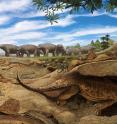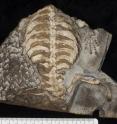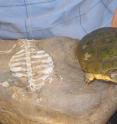Eight-year-old boy discovers early turtle fossil that solves the mystery of the turtle shell
It is common knowledge that the modern turtle shell is largely used for protection. No other living vertebrate has so drastically altered its body to form such an impenetrable protective structure as the turtle. However a new study by an international group of scientists, including those from the Evolutionary Science Institute at Wits University, on the earliest partially shelled fossil turtles suggests the broad ribbed proto shell was initially an adaptation, not for protection, but rather for burrowing underground.
Lead author Dr. Tyler Lyson of the Denver Museum of Nature and Science says, "Why the turtle shell evolved is a very Dr. Seuss like question and the answer seems pretty obvious - it was for protection. But just like the bird feather did not initially evolve for flight - we now have early relatives of birds such as tyrannosaur dinosaurs with feathers that definitely were not flying - the earliest beginnings of the turtle shell was not for protection but rather for digging underground to escape the harsh South African environment where these early proto turtles lived".
The early evolution of the turtle shell had long puzzled scientists. "We knew from both the fossil record and observing how the turtle shell develops in modern turtles that one of the first major changes towards a shell was the broadening of the ribs," says Dr. Lyson. While distinctly broadened ribs may not seem like a significant modification, it has a serious impact on both breathing and speed in quadrupedal animals.
Ribs are used to support the body during locomotion and play a crucial role in ventilating your lungs. Distinctly broadened ribs stiffen the torso, which shortens an animal's stride length and slows it down and interferes with breathing. "The integral role of ribs in both locomotion and breathing is likely why we don't see much variation in the shape of ribs," says Dr. Lyson. "Ribs are generally pretty boring bones. The ribs of whales, snakes, dinosaurs, humans, and pretty much all other animals look the same. Turtles are the one exception, where they are highly modified to form the majority of the shell."
A big breakthrough came with the discovery of several specimens of the oldest (260 million year old) partially shelled proto turtle, Eunotosaurus africanus, from the Karoo Basin of South Africa. Several of these specimens were discovered by two of the studies' co-authors, Drs. Roger Smith and Bruce Rubidge from the University of Witwatersrand, in Johannesburg but the most important specimen was found by a then eight-year-old South African boy on his father's farm in the Western Cape of South Africa.
This specimen, which is about 15 cm long, comprises a well preserved skeleton together with the fully articulated hands and feet. "I want to thank Kobus Snyman and shake his hand because without Kobus both finding the specimen and taking it to his local museum, the Fransie Pienaar Museum in Prince Albert, this study would not have been possible," says Prof Rubidge.
Source: University of the Witwatersrand
Other sources
- 8-Year-Old's Fossil Discovery Explains Why Turtles Have Shellsfrom Live ScienceMon, 18 Jul 2016, 17:31:13 UTC
- Real reason turtles have shells: Burrowing toolfrom Science DailySun, 17 Jul 2016, 19:01:15 UTC
- Study reveals origins of the turtle shellfrom UPIFri, 15 Jul 2016, 21:21:13 UTC
- Researchers discover real reason why turtles have shellsfrom PhysorgFri, 15 Jul 2016, 20:11:06 UTC


